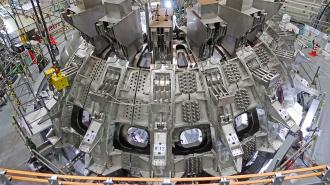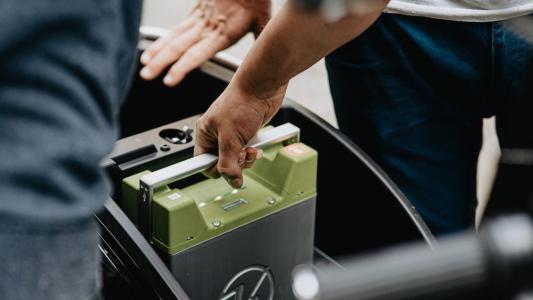A massive nuclear fusion experiment in Japan just hit a major milestone, potentially putting us a little closer to a future of limitless clean energy.
Nuclear fusion 101: Nuclear fusion is a process in which two atoms merge into one (unlike conventional nuclear power, which relies on fission — splitting an atom into two). This releases an incredible amount of energy in the form of heat, so much heat, in fact, that it can power the sun and other stars.
If we could harness the heat from nuclear fusion here on Earth, we could use it to generate electricity on-demand without worrying about carbon emissions, nuclear waste, or running out of fuel — the hydrogen and lithium atoms we’d use to create fuel are plentiful.
During nuclear fusion, two atoms merge into one, releasing a tremendous amount of energy.
The challenge: Sustaining the conditions of the sun’s interior here on Earth is tricky, to put it mildly: to get hydrogen atoms to fuse, we need to subject them to extreme pressure and temperatures above 180 million degrees Fahrenheit (100 million degrees Celsius), and we have to control the super hot plasma to sustain the reaction.
While scientists have recently managed to generate slightly more energy from fusion than they put into it, it’ll likely be decades before they overcome the many hurdles to developing a commercial fusion reactor.
What’s new? A fusion research device in Japan could play a pivotal role in the development of those future reactors.
This machine, JT-60SA, is a tokamak: a hollow, donut-shaped device surrounded by magnetic coils. These machines are one of the best ways we’ve found to confine a super-hot plasma so that fusion can occur (stellarators are another).
The JT-60SA is now the biggest tokamak to reach first plasma anywhere in the world.
On October 23, the National Institutes for Quantum Science and Technology announced that it had achieved “first plasma” at the JT-60SA, meaning the device was used to create and contain a super-hot plasma for the first time — a milestone in the development of a tokamak.
Stepping stone: At 52 feet tall, the JT-60SA is now the biggest tokamak to reach first plasma anywhere in the world — but it likely won’t be for long.
The JT-60SA tokamak is being built to support ITER, an under-construction tokamak twice as tall. Once that device achieves first plasma — currently scheduled for December 2025 — it’ll become the largest nuclear fusion device to fire up.
While fusion projects rarely go quite as planned, the hope is that ITER will be the device that finally proves commercial fusion power is possible — ushering in a new era in clean energy.
We’d love to hear from you! If you have a comment about this article or if you have a tip for a future Freethink story, please email us at [email protected].






